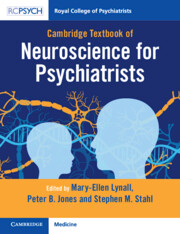Book contents
- Cambridge Textbook Of Neuroscience for Psychiatrists
- Reviews
- Cambridge Textbook of Neuroscience for Psychiatrists
- Copyright page
- Contents
- Contributors
- Introduction
- 1 Cells
- 2 Neurotransmitters and Receptors
- 3 Basic Techniques in Neuroscience
- 4 Neuroanatomy
- 5 Neural Circuits
- 6 Modulators
- 7 Genetics
- 8 Neurodevelopment and Neuroplasticity
- 8.1 The Development of Brain Structure and Function
- 8.2 Neurodevelopmental Models of Psychiatric Disorders
- 8.3 Attachment
- 8.4 Neuroplasticity
- 8.5 Intelligence and Intellectual Disability
- 9 Integrated Neurobiology of Specific Syndromes and Treatments
- 10 Neurodegeneration
- Index
- References
8.3 - Attachment
from 8 - Neurodevelopment and Neuroplasticity
Published online by Cambridge University Press: 08 November 2023
- Cambridge Textbook Of Neuroscience for Psychiatrists
- Reviews
- Cambridge Textbook of Neuroscience for Psychiatrists
- Copyright page
- Contents
- Contributors
- Introduction
- 1 Cells
- 2 Neurotransmitters and Receptors
- 3 Basic Techniques in Neuroscience
- 4 Neuroanatomy
- 5 Neural Circuits
- 6 Modulators
- 7 Genetics
- 8 Neurodevelopment and Neuroplasticity
- 8.1 The Development of Brain Structure and Function
- 8.2 Neurodevelopmental Models of Psychiatric Disorders
- 8.3 Attachment
- 8.4 Neuroplasticity
- 8.5 Intelligence and Intellectual Disability
- 9 Integrated Neurobiology of Specific Syndromes and Treatments
- 10 Neurodegeneration
- Index
- References
Summary
Since articulated by John Bowlby in the late 1960s, attachment theory has become foundational for our understanding of how early experience may shape neurodevelopment and later psychopathology. Using well-validated instruments to measure attachment, such as the Strange Situation Procedure and the Adult Attachment Interview, variations in human attachment have been observed and linked to differences in brain, endocrine and behavioural responses. These observations closely parallel non-human animal models of caregiving and social behavior, which also provide more detailed data on neuroendocrine mechanisms. Understanding the neurobiology of attachment has also led to some novel approaches to therapeutic intervention.
- Type
- Chapter
- Information
- Cambridge Textbook of Neuroscience for Psychiatrists , pp. 354 - 365Publisher: Cambridge University PressPrint publication year: 2023

